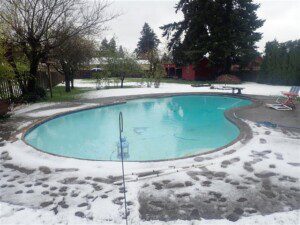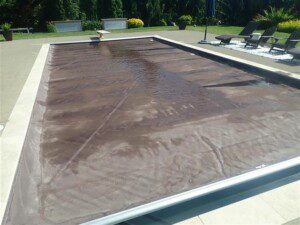
To begin, ladders, floaties, cleaners, and any other object not fitted to the pool surface should be removed.
Second, balance the water chemistry. Chemical testing strips are inexpensive and will come with a color range for ideal pool chemistry. Typically, pH should be between 7.2-7.4. Calcium hardness should be greater than 180 ppm, and total alkalinity should be between 80 and 150 ppm. This is a key step as a pool with poor water chemistry that sits untouched for several months can develop significant algae growth. Algae growth can be difficult to remove and can decrease the service life of the pool finish.
Third, the pool should be cleaned thoroughly. Remove any debris on top of the pool water with a skimmer net. Use a pool vacuum to remove debris on the bottom of the pool. A brush can be used to remove any visible algae on the surface.
After removing debris, the water level should be dropped below the skimmers and inlets. This will help to prevent water from entering the plumbing system where it could freeze and damage the plumbing lines.

The following step is to add closing kit chemicals to your pool. These kits typically include pool shock, algaecide, stain/scale preventer, and oxidizing chemicals. These chemicals will help to maintain the pool chemistry during the months of unuse.
Next, blow all the water out of the plumbing lines with the help of a small air compressor. Blowing out the lines will help prevent damage from freezing during winter weather.
Finally, cover the pool. Automatic pool covers are the most convenient option. However, if your pool does not have an automatic cover there are other options for effective covers. Anchor covers have a series of recessed anchors around the pool deck that can be lifted once it is time to install the cover. Other covers are held to the pool deck using water bags or blocks. Whichever cover is used, it is important to ensure there are no visible gaps between the pool deck and the pool vessel.
A homeowner can perform swimming pool winterization; however, pool maintenance companies also offer this service. We recommend contacting a qualified company for further information about options for winterizing your pool.
